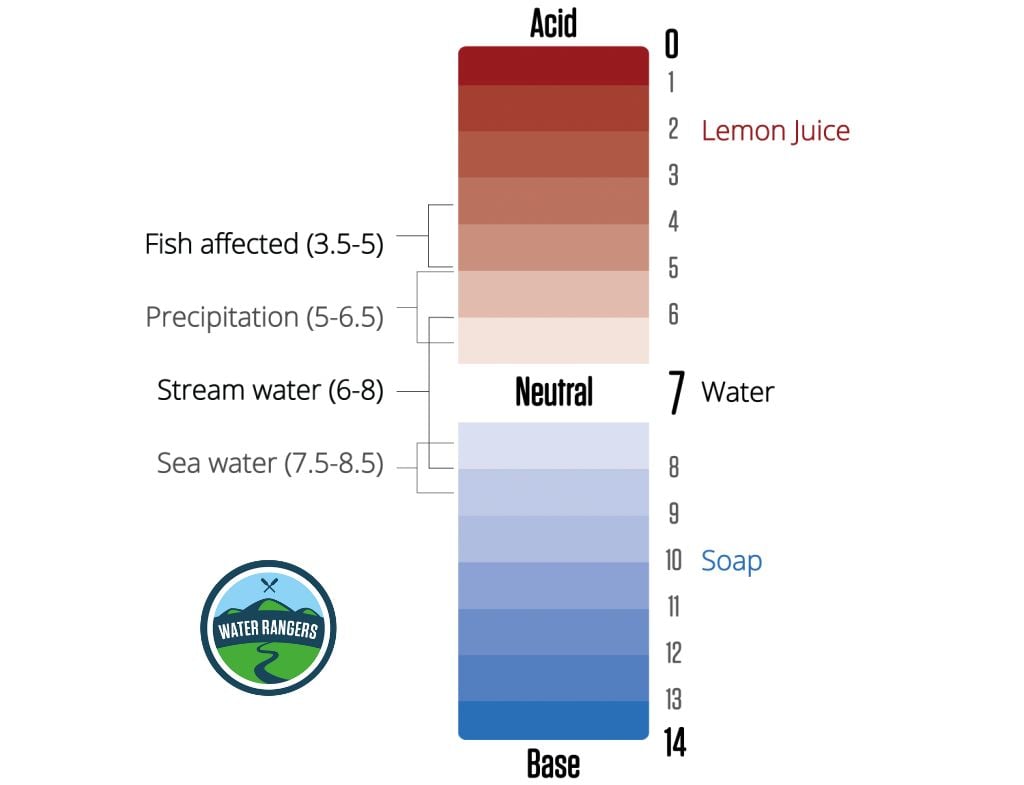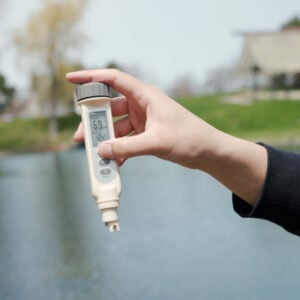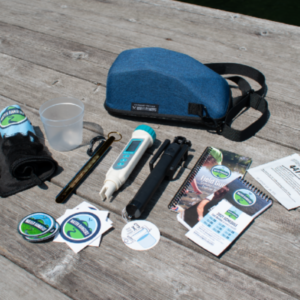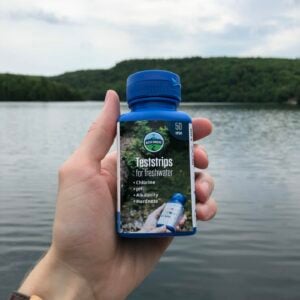pH in freshwater
What is pH?
pH stands for “potential for Hydrogen.” It measures how acidic or basic (alkaline) a liquid is. pH ranges on a scale from 0 (very acidic) to 14 (very basic) and uses a logarithmic scale. While the difference between a pH of 6 and a pH of 8 may seem small, a pH value of 6 is actually 100 times more acidic than a value of 8!

Why is pH important in freshwater?
In freshwater systems, pH plays a critical role in determining the conditions for life. pH influences the availability of nutrients and how easily heavy metals, which are toxic to aquatic life, can dissolve in the water. If the pH falls below 5 or over 10, you will start to see fish life spans and reproduction affected. Low pH can reduce the number of fish eggs that successfully hatch and make life difficult for fish and macroinvertebrates (the small creatures that are the backbone of our water ecosystems). Amphibians are also very sensitive to low pH because of their sensitive skin.
What does a pH measurement mean?
Rivers and lakes generally have a pH between 5 (acidic) and 9 (basic). Whereas, pH in saltwater averages closer to 8.2 (slightly basic). The most important thing is establishing a baseline for testing to understand what is normal for the waterbody you are testing. For example, the Rideau River drains into the Ottawa River, and yet the typical pH of each is quite different. The Ottawa River’s pH is usually around 7, while the Rideau River is 10 times more basic, with a normal pH level around 8.
Common values for pH in freshwater

Did you know
-
- Coloured water tends to be more acidic, so it may have a lower pH than clear water.
-
- Human influence through dumping can change pH levels. Acid rain, mining run-off, and pine forests all lower the pH of water systems.
-
- Plants affect pH over a day through photosynthesis and respiration: pH will be highest in the afternoon and lowest before sunrise.
Algae Blooms
Harmful algae is a growing concern for lakes and are made worse by excess nutrients from human activity. Algae blooms have an optimum pH between 8.2 – 8.7 and usually appear in late summer/early fall. When algae grows, pH levels go up, and can reach over 10 (all fish die above 10)! Some algae is normal. However, if you you see a lot, be careful as some are toxic!
Water Rangers testing protocol
For this test, we use Taylor Pool and Spa Test Strips.
Research
We’ve compared 15 types of test strips, and those made by Taylor have been shown to be the most accurate.
How to test
- Rinse your sample cup 3 times.
- IMPORTANT! Make sure your hands are dry. Any moisture in the container will ruin the strips.
- Shake out 1 test strip and close the bottle.
- Dip the entire strip in the water. Remove after 2 seconds. Don’t shake the strip!
- Wait 20 more seconds before reading.
- Compare colours with the guide on the side of the bottle. Line up the colour strips vertically to compare along the spectrum for each value.
Pro Tip: If the colour on the test strip appears in the middle of two colours on the bottle, you can record the absolute middle (for example, if the colour is somewhere between 6.8 and 7.2, then record a value of 7).

How to calibrate and use the pH meter
For those looking for more accuracy, inexpensive pen-style meters have proven to be very accurate. Water Rangers offers this pH meter.
Calibration process
The pH meter needs to be calibrated to ensure accurate measurements. Without calibration, the meter readings can drift over time, leading to inaccuracies. If you are testing daily, the meters should be calibrated at least once a day.
Items you will need:
- pH packets provided in your test kits with pH of 4, 7, and 10.
- Jars or bottles that can hold at least 250 mL of liquid.
- 4 Liters of distilled water for calibration solutions and rinsing.
- Water Rangers cloth for cleaning/wiping.
To perform the calibration, follow these steps:
- Fill 3 clean, resealable jars or bottles with 250mL of distilled water each
- Label containers for each pH solution: 4, 7, 10.
- Open calibration packets and pour contents of each pH range into separate containers (follow the labels).
- Stir with a clean utensil and wait for 30 minutes or until the powders have completely dissolved.
- Take out your pH meter and power it on.
- Press “CAL” on the pH meter to start the calibration process. The meter will flash 4, 7, and 10 in a cycle. This means it is ready to be calibrated.
- For better accuracy, always start with the solution with a pH of 7 and then move on to 4 or 10 in no particular order.
- Dip the meter into the solution and wait. The meter will recognize the solution’s pH and indicate it on the screen. For the first calibration, 7!
- Once the meter reads a stable value, without pressing a single key, the meter will automatically save the value and return to the measurement screen.
- Rinse and repeat this process for pH 4 and pH 10. Make sure to rinse the meter every time you calibrate it.
- Store the calibration solution in a cool location. They can last up to 3-4 weeks and can be reused.
Taking a measurement
- Rinse the sample cup three times before taking the final sample for the measurement. If possible and safe, you can also dip the meter right into the waterbody.
- Dip the meter into the water and wait for the number on the screen to stabilize before recording the number. You can even press the “HLD” or the hold button to freeze the reading so you can take notes without it changing.
- Since pH is affected by water temperature, you should also use this to record water temperature.
- After the measurement, rinse the probe with distilled water before the next measurement or before storing it.
Things to keep in mind!
- To prolong the life of the meter, keep the pH glass bulb wet by using the cap to protect and store the electrode.
- Make sure to always rinse the probe of the meter before using and between measurements.
- NEVER touch the glass bulb, as it is very delicate and can alter your readings.
- If you are testing on a monthly basis, you will have to calibrate the meter every time before heading out.
Start testing pH with these products:
-
pH meter$70.00
-
Compact Freshwater Testkit$155.00
-
Teststrips$17.50
Contributing to the community!
Water Rangers is citizen-scientist led. So, if you have any questions, ideas, or notice any errors, please tell us!


